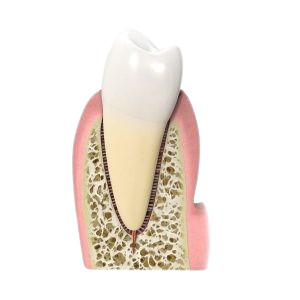Periodontal disease
Expert Care for Healthy Gums


Gum disease (Periodontal disease) is a very common condition affecting the teeth. It is a chronic infection starting in the gums, which over a period of time dissolves the bone that supports the teeth. For a long time, it may not cause any major problems. One can get subtle symptoms such as occasional gum bleeding, metallic taste or bad breath. However, if not treated, it will cause premature loss of some or all the teeth. Every dental surgeon is trained to diagnose and treat initial and moderate phases of gum disease. That is why it is important to have a check up at least once a year.
We are all different. Roughly 10% of the population is very resistant to gum disease. These people may have bleeding gums but nothing more than that.
On the other hand, approximately 10% of people are very susceptible to gum disease. This group is highly likely to develop symptoms of gum disease very early in life – loose and splayed teeth or bleeding and receding gums.
The remaining 80% of us is somewhere in between – more or less susceptible. For this reason you can hear all sort of stories – of those who never brush their teeth and still have them and those who always kept their teeth very clean but ended up losing them.
To be susceptible means to be more vulnerable to some disease and be prone to develop it easier. It doesn’t mean that you have to get it!
The tooth is unique in the sense that it has a portion which is in the bone – its root (free from bacteria) and a portion exposed in the mouth – the crown (always colonized with bacteria). Bacteria (‘germs’) can float in the saliva or grow on hard surfaces – teeth, dentures etc. Those ‘swimming’ in the saliva are harmless. Those ‘sitting down’ on the tooth form a plaque (organised sticky white matter covering teeth, that has not been brushed for a day or more). The presence of this stagnant plaque close to the gum causes inflammation. Tooth brushing and flossing removes the plaque – where there is no plaque, there is no gum disease. It is important that you are advised individually on an adequate cleaning method that suits your teeth. Ask your dentist or dental hygienist for advice, they will be pleased to help.
In the case that gum disease has already done damage, you can still save the tooth. We always advise to look at the problem from different angles. One needs to consider how important the tooth is from a functional and cosmetic point of view, how practical it is to maintain the tooth or replace it and what the financial implications of the decision would be.
A lot can be done to keep the tooth in place. Often, getting the infection under control is all that is needed. If one cannot maintain the affected tooth clean on the day-to-day basis, it is possible to reshape the tissues around it in order to make it cleanable (small periodontal surgery). Where indicated we can encourage the body’s tendency to regenerate lost gum by employing the principles of ‘guided tissue regeneration’. It may be more appropriate to simplify the root’s shape and remove any non-functional root. There are also instances where patients come to the conclusion that it is more practical to remove the tooth and replace it with an implant, denture or a bridge. On our part, comprehensive analysis is crucial so that you make the right choice.






